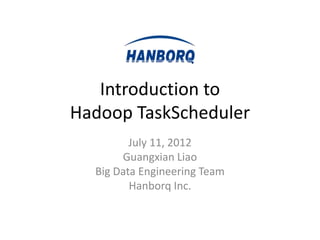Hadoop MapReduce Task Scheduler Introduction
0 likes1,282 views
Introduction of Hadoop MapReduce Task Scheduler, for training.
1 of 11











Recommended
Hadoop 設定與配置



Hadoop 設定與配置鳥 藍 Hadoop & MapReduce 介紹
Hadoop 簡介
Hadoop 之 MapReduce 作法
MapReduce 的類型與格式
Hadoop 分散式檔案系統HDFS作法
Hadoop 叢集及管理
巨量分析工具與使用案例介紹 RHadoop
Hadoop 簡介 教師 許智威



Hadoop 簡介 教師 許智威Awei Hsu 雲端運算概論 (Fundamentals of Cloud Computing 4D031 ) Vision - Hadoop & MapReduce 介紹課程 之 Hadoop 簡介
Spark性能调优分享



Spark性能调优分享Wenchun Xu my experience in spark tunning. All tests are made in production environment(600+ node hadoop cluster). The tunning result is useful for Spark SQL use case.
Hadoop-分布式数据平台



Hadoop-分布式数据平台Jacky Chi 在云计算和大数据大行其道的今天,Hadoop及其相关技术起到了非常重要的作用,是这个时代不容忽视的一个技术平台。事实上,由于其开源、低成本和和前所未有的扩展性,Hadoop正成为新一代的数据处理平台。
HDInsight for Microsoft Users



HDInsight for Microsoft UsersKuo-Chun Su 1. ggplot R package 提供的測試資料網址是 http://had.co.nz/data/movies/,解壓縮之後放在 movies 目錄裡面。(http://1drv.ms/1w5Rfon 裡面有一份)
2. 請下載安裝 CloudBerry Explorer,網址是 http://www.cloudberrylab.com/free-microsoft-azure-explorer.aspx。
HDInsight for Hadoopers



HDInsight for HadoopersKuo-Chun Su A brief introduction to Microsoft Azure HDInsight service for current Hadoop users.
Hadoop ecosystem - hadoop 生態系



Hadoop ecosystem - hadoop 生態系Wei-Yu Chen 使用情境案例式來討論 hadoop 的解決方式
如使用 flume, sqoop, pig, hive, hbase, oozie 等解決方案
Hadoop architecture by ajay



Hadoop architecture by ajayHadoop online training More about Hadoop
www.beinghadoop.com
https://www.facebook.com/hadoopinfo
This PPT Gives information about
Complete Hadoop Architecture and
information about
how user request is processed in Hadoop?
About Namenode
Datanode
jobtracker
tasktracker
Hadoop installation Post Configurations
Hadoop Summit 2012 | Optimizing MapReduce Job Performance



Hadoop Summit 2012 | Optimizing MapReduce Job PerformanceCloudera, Inc. Optimizing MapReduce job performance is often seen as something of a black art. In order to maximize performance, developers need to understand the inner workings of the MapReduce execution framework and how they are affected by various configuration parameters and MR design patterns. The talk will illustrate the underlying mechanics of job and task execution, including the map side sort/spill, the shuffle, and the reduce side merge, and then explain how different job configuration parameters and job design strategies affect the performance of these operations. Though the talk will cover internals, it will also provide practical tips, guidelines, and rules of thumb for better job performance. The talk is primarily targeted towards developers directly using the MapReduce API, though will also include some tips for users of higher level frameworks.
More Related Content
What's hot (20)
Spark性能调优分享



Spark性能调优分享Wenchun Xu my experience in spark tunning. All tests are made in production environment(600+ node hadoop cluster). The tunning result is useful for Spark SQL use case.
Hadoop-分布式数据平台



Hadoop-分布式数据平台Jacky Chi 在云计算和大数据大行其道的今天,Hadoop及其相关技术起到了非常重要的作用,是这个时代不容忽视的一个技术平台。事实上,由于其开源、低成本和和前所未有的扩展性,Hadoop正成为新一代的数据处理平台。
HDInsight for Microsoft Users



HDInsight for Microsoft UsersKuo-Chun Su 1. ggplot R package 提供的測試資料網址是 http://had.co.nz/data/movies/,解壓縮之後放在 movies 目錄裡面。(http://1drv.ms/1w5Rfon 裡面有一份)
2. 請下載安裝 CloudBerry Explorer,網址是 http://www.cloudberrylab.com/free-microsoft-azure-explorer.aspx。
HDInsight for Hadoopers



HDInsight for HadoopersKuo-Chun Su A brief introduction to Microsoft Azure HDInsight service for current Hadoop users.
Hadoop ecosystem - hadoop 生態系



Hadoop ecosystem - hadoop 生態系Wei-Yu Chen 使用情境案例式來討論 hadoop 的解決方式
如使用 flume, sqoop, pig, hive, hbase, oozie 等解決方案
Viewers also liked (6)
Hadoop architecture by ajay



Hadoop architecture by ajayHadoop online training More about Hadoop
www.beinghadoop.com
https://www.facebook.com/hadoopinfo
This PPT Gives information about
Complete Hadoop Architecture and
information about
how user request is processed in Hadoop?
About Namenode
Datanode
jobtracker
tasktracker
Hadoop installation Post Configurations
Hadoop Summit 2012 | Optimizing MapReduce Job Performance



Hadoop Summit 2012 | Optimizing MapReduce Job PerformanceCloudera, Inc. Optimizing MapReduce job performance is often seen as something of a black art. In order to maximize performance, developers need to understand the inner workings of the MapReduce execution framework and how they are affected by various configuration parameters and MR design patterns. The talk will illustrate the underlying mechanics of job and task execution, including the map side sort/spill, the shuffle, and the reduce side merge, and then explain how different job configuration parameters and job design strategies affect the performance of these operations. Though the talk will cover internals, it will also provide practical tips, guidelines, and rules of thumb for better job performance. The talk is primarily targeted towards developers directly using the MapReduce API, though will also include some tips for users of higher level frameworks.
Hadoop Internals (2.3.0 or later)



Hadoop Internals (2.3.0 or later)Emilio Coppa Apache Hadoop: design and implementation. Lecture in the Big data computing course (http://twiki.di.uniroma1.it/twiki/view/BDC/WebHome), Department of Computer Science, Sapienza University of Rome.
Hadoop Summit Europe 2014: Apache Storm Architecture



Hadoop Summit Europe 2014: Apache Storm ArchitectureP. Taylor Goetz Storm is an open-source distributed real-time computation system. It uses a distributed messaging system to reliably process streams of data. The core abstractions in Storm are spouts, which are sources of streams, and bolts, which are basic processing elements. Spouts and bolts are organized into topologies which represent the flow of data. Storm provides fault tolerance through message acknowledgments and guarantees exactly-once processing semantics. Trident is a high-level abstraction built on Storm that supports operations like aggregations, joins, and state management through its micro-batch oriented and stream-based API.
Hadoop introduction , Why and What is Hadoop ?



Hadoop introduction , Why and What is Hadoop ?sudhakara st Hadoop Introduction
you connect with us: http://www.linkedin.com/profile/view?id=232566291&trk=nav_responsive_tab_profile
Seminar Presentation Hadoop



Seminar Presentation HadoopVarun Narang The document discusses big data and distributed computing. It provides examples of the large amounts of data generated daily by organizations like the New York Stock Exchange and Facebook. It explains how distributed computing frameworks like Hadoop use multiple computers connected via a network to process large datasets in parallel. Hadoop's MapReduce programming model and HDFS distributed file system allow users to write distributed applications that process petabytes of data across commodity hardware clusters.
Similar to Hadoop MapReduce Task Scheduler Introduction (20)
Hadoop 0.23 m_rv2_introduction



Hadoop 0.23 m_rv2_introductionJinGui LI Introduction about Hadoop YARN.
BTW:
这是我的每周讨论会上某次报告,内容不多。
从Google Docs导出再导入slideshare,格式有点不对,怎么首页就变形了?!
诗檀软件 Oracle开发优化基础 



诗檀软件 Oracle开发优化基础 maclean liu 数据库开发员需要注意些什么
如何快速定位及认知数据库问题点
如何编写高性能SQL – 基础知识
如何编写高性能SQL – 执行计划
调整思路
如何编写高性能SQL – PLSQL优化Tips
Large-Scale Cluster Mangement & Kubernetes Under The Hood



Large-Scale Cluster Mangement & Kubernetes Under The HoodLei (Harry) Zhang Borg, large-scale cluster,& Kubernetes under the hood
基于Spring batch的大数据量并行处理



基于Spring batch的大数据量并行处理Jacky Chi Spring Batch一款优秀的、开源的大数据量并行处理框架。通过Spring Batch可以构建出轻量级的健壮的并行处理应用,支持事务、并发、流程、监控、纵向和横向扩展,提供统一的接口管理和任务管理
More from Hanborq Inc. (12)
Introduction to Cassandra



Introduction to CassandraHanborq Inc. Apache Cassandra is an open-source distributed database designed to handle large amounts of data across commodity servers in a highly available manner without single points of failure. It uses a gossip protocol for cluster membership and a Dynamo-inspired architecture to provide availability and partition tolerance, while supporting eventual consistency.
Hadoop HDFS NameNode HA



Hadoop HDFS NameNode HAHanborq Inc. This document outlines and compares two NameNode high availability (HA) solutions for HDFS: AvatarNode used by Facebook and BackupNode used by Yahoo. AvatarNode provides a complete hot standby with fast failover times of seconds by using an active-passive pair and ZooKeeper for coordination. BackupNode has limitations including slower restart times of 25+ minutes and supporting only two-machine failures. While it provides hot standby for the namespace, block reports are sent only to the active NameNode, making it a semi-hot standby solution. The document also briefly mentions other experimental HA solutions for HDFS.
FlumeBase Study



FlumeBase StudyHanborq Inc. This document summarizes a study on FlumeBase, a system for processing streaming data using SQL queries. It describes FlumeBase's architecture, including how it integrates with Flume and uses SQL queries to define streams, flows, and flow elements for aggregating data. The document notes some potential issues with FlumeBase regarding window alignment, deployment integration with Flume, and code maturity.
Flume and Flive Introduction



Flume and Flive IntroductionHanborq Inc. This document introduces Flume and Flive. It summarizes that Flume is a distributed data collection system that can easily extend to new data formats and scales linearly as new nodes are added. It discusses Flume's core concepts of events, flows, nodes, and reliability features. It then introduces Flive, an enhanced version of Flume developed by Hanborq that provides improved performance, functionality, manageability, and integration with Hugetable.
Hadoop MapReduce Streaming and Pipes



Hadoop MapReduce Streaming and PipesHanborq Inc. Hadoop Streaming allows any executable or script to be used as a MapReduce job. It works by launching the executable or script as a separate process and communicating with it via stdin and stdout. The executable or script receives key-value pairs in a predefined format and outputs new key-value pairs that are collected. Hadoop Streaming uses PipeMapper and PipeReducer to adapt the external processes to the MapReduce framework. It provides a simple way to run MapReduce jobs without writing Java code.
HBase Introduction



HBase IntroductionHanborq Inc. HBase is an open source, distributed, sorted key-value store modeled after Google's BigTable. It uses HDFS for storage and provides random read/write access to large datasets. Data is stored in tables with rows sorted by key and columns grouped into column families. The master coordinates region servers that host regions, the distributed units of data. Clients locate data regions and directly communicate with region servers to read and write data.
Hadoop Versioning



Hadoop VersioningHanborq Inc. This document discusses the versioning conventions and history of Hadoop releases. It notes that features were occasionally developed on branches off the trunk codeline and that some releases included features from different branches, causing confusion. It also summarizes the status of Hadoop 1.0, which unified many previously separated features, and the versioning of the Cloudera CDH distribution in relation to Apache Hadoop releases.
Hadoop MapReduce Introduction and Deep Insight



Hadoop MapReduce Introduction and Deep InsightHanborq Inc. Hadoop MapReduce introduces YARN, which separates cluster resource management from application execution. YARN introduces a global ResourceManager and per-node NodeManagers to manage resources. Applications run as ApplicationMasters and containers on the nodes. This improves scalability, fault tolerance, and allows various application paradigms beyond MapReduce. Optimization techniques for MapReduce include tuning buffer sizes, enabling sort avoidance when sorting is unnecessary, and using Netty and batch fetching to improve shuffle performance.
Hadoop HDFS Detailed Introduction



Hadoop HDFS Detailed IntroductionHanborq Inc. The document provides an overview of the Hadoop Distributed File System (HDFS). It describes HDFS's master-slave architecture with a single NameNode master and multiple DataNode slaves. The NameNode manages filesystem metadata and data placement, while DataNodes store data blocks. The document outlines HDFS components like the SecondaryNameNode, DataNodes, and how files are written and read. It also discusses high availability solutions, operational tools, and the future of HDFS.
How to Build Cloud Storage Service Systems



How to Build Cloud Storage Service SystemsHanborq Inc. RockStor vs. S3.
uDrop vs. Dropbox
在北航云计算公开课的演讲
Hanborq Optimizations on Hadoop MapReduce



Hanborq Optimizations on Hadoop MapReduceHanborq Inc. A Hanborq optimized Hadoop Distribution, especially with high performance of MapReduce. It's the core part of HDH (Hanborq Distribution with Hadoop for Big Data Engineering).
Hadoop MapReduce Task Scheduler Introduction
- 1. Introduction to Hadoop TaskScheduler July 11, 2012 Guangxian Liao Big Data Engineering Team Hanborq Inc.
- 2. MapReduce任务调度 • 配置:mapred.jobtracker.taskScheduler • 插件式Task调度器 • 基类TaskScheduler • JT收到TT的心跳时,使用调度器分配Task 2
- 3. Task调度器 调度器 介绍 JobQueueTaskScheduler 一个队列,FIFO,可以指定优先级 CapacityTaskScheduler(contrib目 多个队列,每个队列可以指定资源百分比, 录) FIFO,支持优先级。可以设定单个用户占用 队列资源的百分比上限 FairScheduler(contrib目录) 默认每个用户有单独的Job pool,缺省平均 分配资源,每个job可以配置优先级,每个 pool可以配置权值和最低资源保障,支持 Slot抢占。 LimitTasksPerJobTaskScheduler 基本功能和JobQueueTaskScheduler一样,可 以指定每个Job同时运行的Task数量上限 mapred.jobtracker.scheduler.maxRunningTasks PerJob 3
- 4. JobQueueTaskScheduler调度策略 • 按照数据局部性分配MapTask。 • 保证每个TaskTracker负载比较均衡。 • 默认TaskTracker和Map处理的数据片(split)在同一个节点或者同一个机 架认为是LocalMapTask。 • 网络拓扑由脚本来提供,脚本负责获取主机对应的拓扑位置。 ${topology.script.file.name} • 可以一次heartbeat分配多个LocalMapTask。 • 如果没有LocalMapTask可以分配,则可以分配一个NonLocalMapTask。 • ReduceTask一次最多分配一个。 4
- 5. FairScheduler配置 • 配置:mapred.fairscheduler.poolnameproperty • Job的poolname由哪个JobConf参数来指定。 • 默认是user.name,按照用户分pool • 也可以指定为mapred.job.queue.name • 或者group.name 5
- 6. FairScheduler配置 • 配置:mapred.fairscheduler.pool • 用户可以直接指定job放入哪个pool • 配置这个参数后,mapred.fairscheduler.poolnameproperty 失效 6
- 8. FairScheduler xml文件举例 • <?xml version="1.0"?> <allocations> <pool name="sample_pool"> <minMaps>5</minMaps> <minReduces>5</minReduces> <weight>2.0</weight> </pool> <user name="sample_user"> <maxRunningJobs>6</maxRunningJobs> </user> <userMaxJobsDefault>3</userMaxJobsDefault> </allocations> 8
- 9. FairScheduler Task抢占 • mapred.fairscheduler.preemption • Default:false • 是否支持抢占 9
- 10. 两种情况会抢占 • 一个Pool一定时间内没有分配到最低的资源 • 一个Job一定时间内没有占用到它应该被分 配资源的一半。 10
- 11. The End Thank You Very Much! [email protected] 11






































